Chuck Wendig's Blog, page 31
April 8, 2022
The Pixel Project: Five Reasons to Give to the Read For Pixels Campaign to Stop Violence Against Women
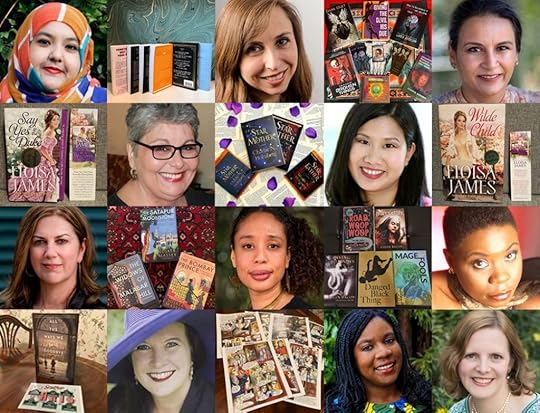
*Accepts the mic from Chuck.* Thank you, Chuck! *clears throat awkwardly* Hey, everybody! Can y’all hear me? Yes? Okay — here we go:
The Pixel Project, a 501(c)3 anti-violence against women nonprofit, has been running our Read For Pixels program since September 2014 when Chuck himself, Joe Hill, Sarah J. Maas, and nine other award-winning bestselling SFF and YA authors answered our call-to-action to help us reach out to their readers and fandoms about violence against women (VAW) and raise funds to keep our anti-VAW work alive.
That inaugural Read For Pixels livestream author interview series and fundraiser was a smashing success and the rest, as the cliché goes, is history. Over 180 authors, 16 campaigns, and almost nine years later, we are continuing to build what is probably the world’s largest repository of recorded livestream interviews and panels with authors speaking out about VAW. These are easily accessible on our YouTube channel to parents, teachers, kids, readers, writers, and fandoms worldwide who can either watch the videos to learn more about VAW while fanning over their favorite authors or use the videos to start conversations about VAW in their communities. Authors and publishers have also helped us raise approximately $10,000 per year by providing exclusive goodies as giveaways for readers, fans, and book collectors who donate to support our work.
You’re probably thinking: “Awesome! I’ll go check it out. So why the guest post on Chuck’s blog?”
The short answer: 2022.
The long answer: If we thought 2021 was bad, 2022 basically said hold my [insert your cuss word of choice here] beer.
Like many small nonprofits, this year we are not just dealing with the fallout from the pandemic, but also global inflation and Russia’s invasion of Ukraine. Women’s organizations have experienced decades of scarce funding for the overall women’s rights movement and women’s human rights are often one of the first casualties in turbulent times such as these. So, with our current Read For Pixels fundraiser moving at the pace of a hobbit wading through the malodorous mud pits of Mordor (it’s been over a month and we’re stuck at $2,787, which is only 55% of the way to our modest $5,000 goal), you can imagine our growing alarm. While we are 100% volunteer-staffed, we need to ensure that we can keep our campaigns, programs, and services running, especially now, when rates of VAW have been spiking so badly the UN calls it “the shadow pandemic”.
Chuck noticed our predicament and, being the mensch that he is, kindly offered to boost the signal for our fundraiser.
So here I am, as Sexual Assault Awareness Month 2022 rolls on, presenting five reasons why you should consider donating to our fundraiser to help get us to our $5,000 finish line by our extended deadline of April 30th 2022:
Reason to Donate #1: Treat yourself while supporting accessible information for victims and survivors of VAW
From signed first editions to goodie bundles to flash fiction/poetry written especially for the donor, we have something for every donation level. (Though, alas, no goodies from Chuck are available during this fundraiser because this is our International Women’s Day fundraiser powered exclusively by women writers.)
And while you’re savoring your goodies, also savor the fact that your donation will be going towards keeping our programs and initiatives that connect victims and survivors of VAW with the help that they need. Programs such as our daily helpline retweet session on Twitter which tweets out domestic violence and rape/sexual assault helplines for women in 205 countries worldwide from 8.00PM to midnight Eastern Time, 24/7, 365 days a year. Right now? Our research and editorial team are working on putting together a starter list of organizations and groups specializing in assisting Ukrainian women and girls who are casualties of wartime sexual violence and human trafficking.
Reason to Donate #2: Treat yourself while supporting resources for educating the world about VAW
We have a stellar line-up of acclaimed authors who have donated critique bundles for WIPs (works-in-progress), including Adiba Jaigirdar (Contemporary YA Romance), Amanda Bouchet (Fantasy Romance and Space Opera), Jeffe Kennedy (SFF, Romance, and Women’s Fiction), and Pintip Dunn (YA Romance). Some have a video chat bundled in; others allow for up to five questions from the donor about the critique; still others offer to look at a query letter draft in addition to your WIP.
All these authors are willing to take time out of their packed schedules to help you when you help keep our anti-VAW educational resources alive. Through our 16 For 16 blogging campaign, we have built an ever-growing archive of over 190 resource articles to date about everything from how to stop street harassment to lists of organizations tackling everything from child marriage to MMIW (Missing and murdered Indigenous women). Additionally, our website has plenty of beginner-level primers about VAW and our Facebook page and Twitter account are excellent just-in-time sources for the latest headlines and articles about VAW.
It’s totally win-win!
Reason to Donate #3: Treat yourself while supporting digital platforms for people to speak up about VAW
It’s good to talk… and even better to talk with your favorite author in the name of supporting a good cause. For this fundraiser, Jeffe Kennedy (Fantasy and Romance), Meg Gardiner (Crime/Thriller), Roseanne A. Brown (YA Fantasy), and Sue Ann Jaffarian (Mystery/Crime) are all happy to spend some quality 1-to-1 time on a video chat with donors to natter about everything from books and writing, to RV life, furbabies, and geeky hobbies.
While you’re chatting away, our Giving The Devil His Due blog tour this April is chock-a-block with book bloggers using our first charity anthology to speak up about VAW during Sexual Assault Awareness Month. We are also working on our Fathers For Pixels program which provides dads worldwide with platforms (blog interviews, panel sessions etc) for sharing their ideas with other dads about raising kids and engaging with their peers and communities about sexism, misogyny, and VAW.
Reason to Donate #4: Treat a friend while supporting signal boosts for anti-VAW activists and advocates worldwide
Do you have a friend or family member with a birthday coming up? Do you see a Read For Pixels goodie offered by their favorite author available on our fundraising page? Donate to snag that unique treat and delight them.
Bonus: You’ll have an interesting story to tell them about where the gift came from. It might even be a great opener for chatting with them about VAW.
Meanwhile, your donation will support our Inspirational Interviews series which has been running for a decade and counting. This blog series shines a spotlight on anti-VAW advocates, activists, and organizations worldwide with a focus on how they are changing the world for women and girls as well as their ideas about what people can do to help stop VAW in their communities and countries.
Reason to Donate #5: Treat yourself because you support the right of women and girls to live a life without VAW
Nearly 1 in 3 women and girls worldwide experience some form of VAW in their lifetime. In terms of domestic violence alone, over 1 in 4 women under 50 have experienced physical or sexual violence from a male partner.
So donate to our fundraiser because you believe in supporting efforts to prevent, stop, and end VAW. Whether you can give us $5 or $500 to help us reach our $5,000 goal, every cent counts.
(And when you donate to us, please also consider donating either cash or supplies to your local women’s shelter or rape crisis center. Like us, they need all the help they can get.)
It’s time to stop violence against women. Together.
***
Interested in checking out The Pixel Project’s anti-violence against women work? Visit us at https://www.thepixelproject.net/
Interested in checking out our Read For Pixels fundraiser and making a donation to help keep our work alive? Go here
***
Regina Yau is the founder and president of The Pixel Project, a virtual volunteer-led global 501(c)3 nonprofit organization on a mission to raise awareness, funds and volunteer power for the cause to end violence against women at the intersection of social media, new technologies, and popular culture/the Arts. A Rhodes Scholar with a double Masters in Women’s Studies and Chinese Studies, she has a lifelong commitment to fighting for women’s rights. In addition to running The Pixel Project, Regina also teaches English to middle-schoolers and high-schoolers, writes stories about cheeky little fox spirits and terrorist chickens, and bakes far too many carb-and-sugar-loaded goodies
March 27, 2022
All The News That’s Fit To Digitally Barf Up Onto A Blog
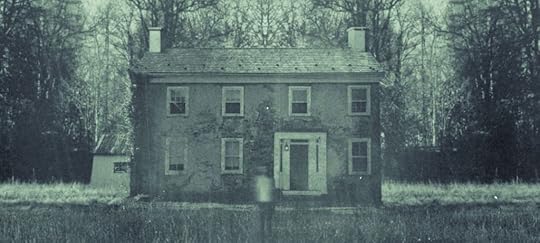
HELLO, FRANDOS.
Once again I return from the digital void to grant you a scattered, smothered, covered, chunked pile of steaming news food. It’s like a newsletter, if you subscribe, and if you don’t, then it’s just a regular old blog post. Magic.
Off Roadin’
So, if you missed it, and I don’t know how you would have given how often I hollered about it, I went out on a mini-book-tour with amazing author friends Kevin Hearne and Delilah Dawson. It was a goddamn delight. If you came out to see us, thank you for doing so. If you didn’t come out to see us, I totally understand and will apply only the gentlest of mystic curses to you and your home. If you find that there’s a piece of furniture on which you stub your toes a lot, that’s probably my fault, but really, isn’t it your fault?
Anyway! We bopped from NYC to Westerly, RI to Framingham, MA, and we got to see fans and readers, plus we got to hang with authorial cohorts like Marko Kloos and Elizabeth Bear and Julie Hutchings, plus wonderful publishing pals like Lauren Panepinto. Plus we got to hang with our friends at Del Rey? And we met a beluga whale. We did not steal it to ride it around, even though we definitely should have. Alas.
It was great, but also, weird? This was our first larger exposure to the “post-pandemic,” and I put that in quotes because hey, as it turns out, there’s still a pandemic even if we choose to ignore it! NYC had pretty solid mask uptake in places, even outside, though that faded a bit once we left the city. There was something mildly rapture-like about heading into the PRH offices, and seeing calendars on the wall last left at February 2020, and seeing galleys from that same year, a place frozen in time. And also meeting people who, like us, really hadn’t been outside of their caves in two years. It was good, and it was necessary, and it felt invigorating in an essential way. Numbers were low, we took our shot, and it paid off. Plus, we sold books. Which is always nice.
Hopefully this summer or fall I’ll get back out on the road again. Stay tuned!
Speaking Of Selling Books
Now that The Book of Accidents is out in paperback, looking over the numbers from that week it sure looks like people came out to support it, so thank you for that. At a rough estimate, the paperback release of TBOA was 4-5 times what we sold for the paperback of Wanderers, and the latter is a book whose sales were routinely pretty solid, even through the pandemic. Not that sales are a metric of a book’s quality, to be clear, but they certainly are a metric of its success in the market — so, thanks for making both books a success.
Reminder that if you missed our tour and you still want signed, personalized copies of The Book of Accidents (or really any of my books), then click on over to Doylestown Bookshop. They can help facilitate and ship the books to you.
The Words Continue Until Morale Improves
I figure I’m due some updates to you, too, about the other books I have in progress, so here’s what’s up with that:
Wayward is now done with copy-edits, and moves onto page proofs. It’s now officially a slightly bigger book than the first book, by about 5000 words, I think. Like Wanderers, it is authoritatively designated an Official Bison Bludgeoner. But please do not bludgeon any bisons with it. The title is symbolic, not instructive. You can preorder Wayward here. It’s out November this year.
I got edits back on my New Writing Book, and that probably deserves a bit of its own story: so, I pitched a book that was essentially a sequel to Damn Fine Story. It was more genre-focused, meant to drill down into how genre affects narrative. But with Writer’s Digest going away for a minute before getting bought by PRH, and with the pandemic, the book’s future was in question — and then I also felt like, hey, I don’t know if I even have the interest in writing that particular book right now. Never mind the fact that I don’t want to launch internecine genre battles on Twitter, I also just felt like my heart wasn’t in it. But there was a different book I had in mind, so I pitched something else to replace it: a book based off my gentle writing advice threads on Twitter and here at the blog. So I wrote that book, and that’s now the book that should one day exist. I suspect it’ll just be called Gentle Writing Advice? We shall see.
I’m currently writing my new apple horror book, which uhhh, is a horror book involving apples? Yeah. It’s a thing. (I think of it as a vampire novel without any actual vampires in it.) It was once called The Orchard, it may now be called The Apple of Harrow, or it may land on a third title, but I’m like, 30-40k into it, and I’m digging it so far, so I’m hoping y’all will dig it, too. That should be out… ennnh, roughly fall 2023? Good Lord Willing and the Covid Don’t Rise, that is.
Folks have asked about a sequel to Dust & Grim and as yet, there’s no news there — we pitched sequels, and are waiting to hear back. More as I know it.
I miiiiiight have some fresh tasty comic work coming out in the next year.
I have film and TV news that I can’t share, because such is the way.
Ta-da.
Petrified Oranges
Please, if you love excellent things, watch Our Flag Means Death. A deeply earnest, weird, wonderful, empathetic, murderous, pirate-based rom-com.
And Now, Photos
Photos from the trip, below!
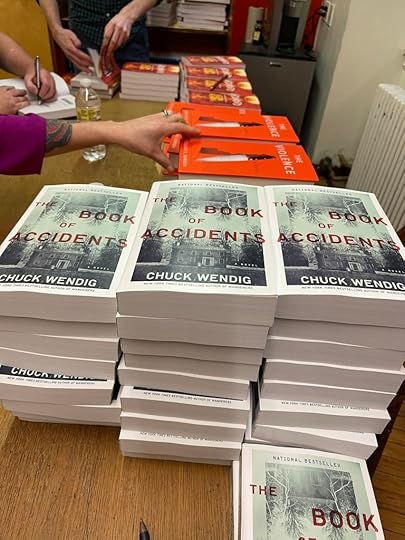
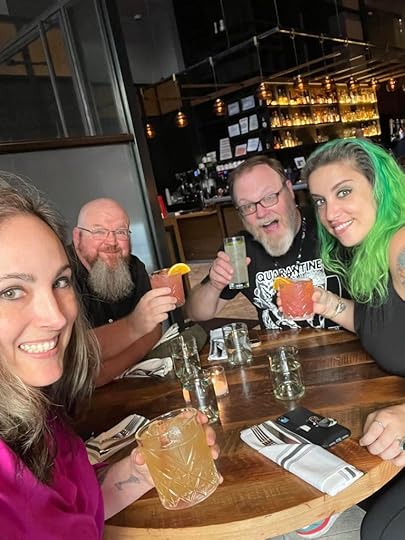
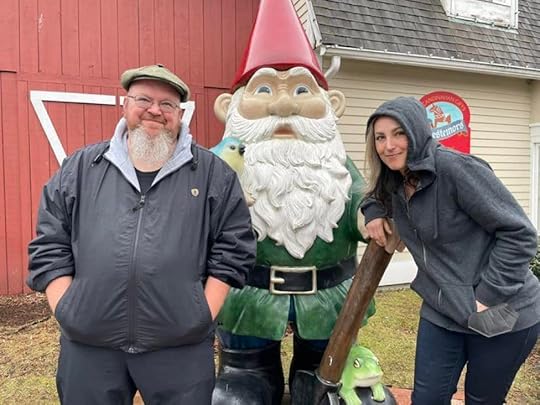
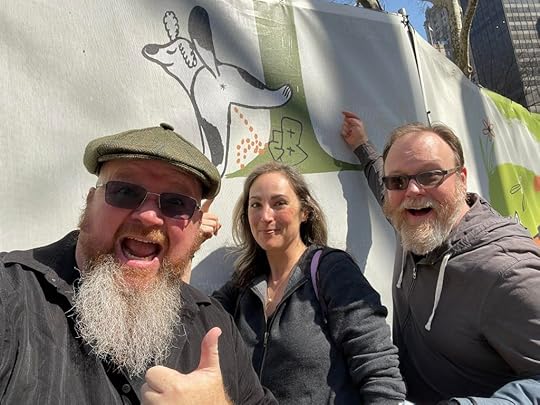
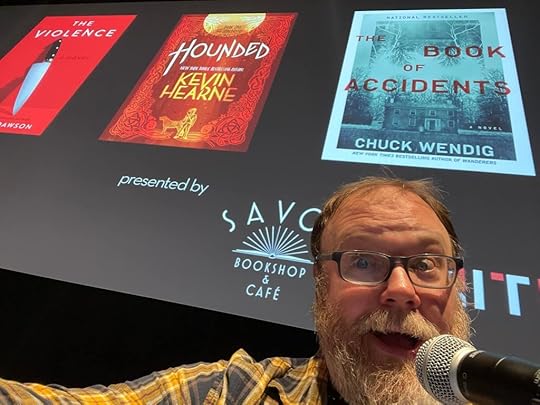
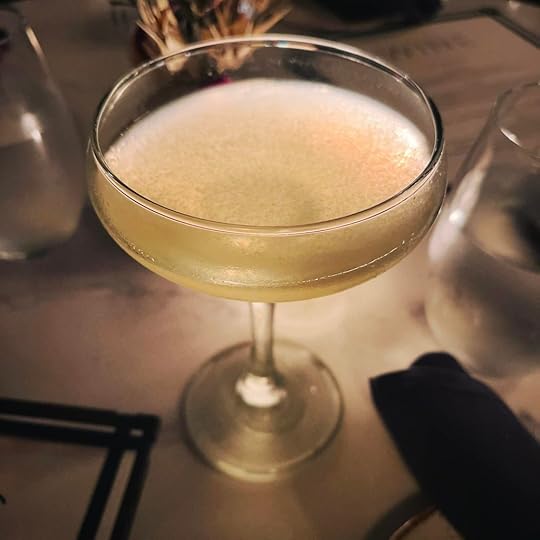
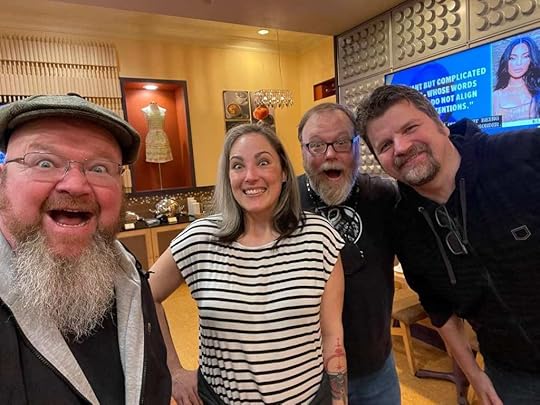
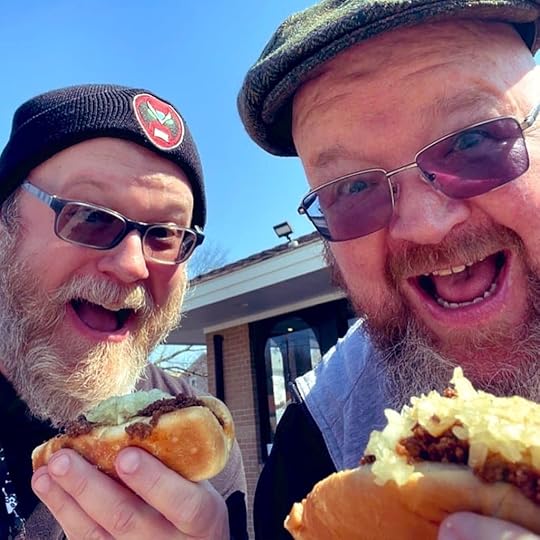

Wait One More Thing
Kevin made me partake in something called either a New York System Wiener or a Rhode Island Hot Wiener, the former of which sounds like a thing an artificial intelligence made up, the latter just, y’know, porn.
It is a kind of chili dog unique-ish to Rhode Island — a red hot on a toasty bun covered in yellow mustard, a kind of meaty treacle adjacent to chili (which may or may not be made of beef heart) and raw onions. They were horrible and delicious, as many things of their ilk are. (Spam, f’rex. I love Spam. It’s horrible.)
The hot dogs haunted me for the rest of the day, first as a kind of volcanic heartburn, and later as, uhh, well let’s just go with, “if my bowels were haunted by oniony meat-ghosts.”
Even still: worth it.
OK BYE
March 15, 2022
Now Out: The Book of Accidents in Paperback

The time has come! The paperback of The Book of Accidents has taken flight and landed on your doorstep like a wooden owl come to life. May contain: a missing serial killer, a haunted coal mine, an interstitial amusement park, an eerie felsenmeer, a soot-caked spellbook, generational trauma, art as magic, empathy as a weapon or weakness, and the power and problem of emotional seawalls.
It is nominated for the Stoker Award this year. It was a national bestseller. And I’m very proud of it. I don’t think we’re really supposed to say that, but it feels good and healthy to say, so goddamnit, here we are.
It’s a book that, as I’ve noted, means quite a lot to me. I’ve tried writing it throughout my life a number of times, and it was only now, with the me that is me at present and not the me of the past, that it made sense and became a proper story. The iterations before were odd, off, not done baking. This one, I think, did what I wanted it to do. And I hope it has, or will, for you, too.
You of course have ways to procure!
Tomorrow I’ll be at The Strand with Kevin Hearne and Delilah S. Dawson, and you can order a signed/personalized copy through there, and pick it up or have it shipped. Order here. Or you can also ask for a signed/personalized copy through my local, Doylestown Bookshop. Note that Kevin and Delilah and I will also be in Westerly, RI (United Theater with Savoy Books!) on Thursday, and Framingham, MA (B&N!) on Friday. In-person! For real! Holy crap!
You can of course also check out the book in other places:
And more.
PLEASE TO ENJOY.
Tell your friends.
Leave a review.
Huzzah.

March 10, 2022
Bits, Bobs, Globs and Blobs: A Post About Many Things
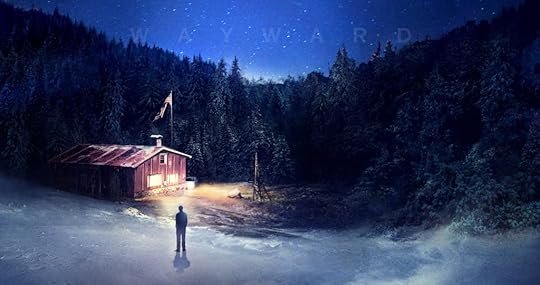
Hey! It’s one of those posts where I unceremoniously shower you in various, unconnected updates, which rain down upon you like glitter and blood. I mean, just glitter. Did I say blood? Ha ha. Hah. Aahhh. Ahem.
Der Eldenringen
I continue to play this game that doesn’t know I’m alive. It’s like the world in that it is a place that exists that I exist inside, but it doesn’t know I exist inside it, for it is a cold and uncaring place with little situational awareness or empathy.
My playthrough at this point has me finally, at like, level 40-something, feeling vaguely powerful. I can walk up to most mobs and wipe the rancid ruined earth with their asses. My strategy became: gallop around the world at top-speed collecting every smithing stone, golden seed, and sacred tear I could fucking find, and juice my gear to their limits. I found a Twinblade, which was a good weapon to bisect chumps with. I also learned the attack move which is called “hop around like an executioner rabbit,” or “like Mario on bloodlust and cocaine,” which is how I mostly engage with enemies. I just jump at them, shrieking, cleaving them in twain. And it mostly works. I do like that no matter how powerful you are, if you don’t pay attention, even a low-ranking mob of dickheads will put you in an early grave.
Apparently I’m also supposed to be… crafting things? I have not been. Uh?
I don’t find the game… difficult, exactly, not in the traditional sense, not in the way it was sold. I just find it distant and disinterested. As I said in my earlier post, it’s not there to help you out. Mostly it shrugs at you and says, “Good luck,” but it says it in a way where it definitely doesn’t mean it. (Here, I recommend Swapna Krishna’s very good Wired piece, ELDEN RING ISN’T MADE FOR ALL GAMERS. I WISH IT WERE.)
I think where the game is going to lose me — though it hasn’t yet, not quite — is that it so relies on you to engage with it on your terms (which is good!) that at a certain point it loses narrative urgency. There’s a threadbare narrative blanketing over what is ostensibly a merciless grind. There isn’t a story so much as there’s “worldbuilding,” and the worldbuilding is mostly a thing to be unearthed actively rather than a thing that matters very much at all. So, I don’t find a great deal of urgency to continue. There’s no mystery to solve, no plot hook to answer, no great revenge, no personal stakes. My motivation is thinning. It was, initially, exploration, but I’ve explored a great deal and at a certain point — you know, I get it. Everything is ruined, everything wants to kill you, I’m something called a Tarnished, blah blah blah be the Elden Lord, as if I want to do that.
I did kill a few bosses, though, which was fun.
Anyway, people ask me why I’m still playing, and I remind them that it’s still friendlier than Twitter.
The Real World Is Bad, Too
It’s getting fucking scary out there. There is a deep, and successful authoritarian push into all corners of this country — attacking everything from abortion rights to the existence of trans and gay kids (and adults) to the very acknowledgment of slavery and the Holocaust. It is a grossly revisionist take on people and history, attempting to erase them instead of reckon with a changing world. It’s bad news. And we’re letting it happen because we aren’t voting. I know, there’s a problematic push to “vote harder,” and I get it, and agree. Just the same, our school board locally is transphobic, antisemitic, and all-around fucking awful, and they’re making some horrific entreaties — they were against masks, they’re for banning books, they’re against trans kids in sports (and in existence, it seems), and the reason they get to do what they do is because not enough people came out to vote in the smaller elections, like the ones that help us decide our fucking school board compositions.
So, I dunno. We gotta stand up for everyone, stand against the erasure, hold back the tide of once-creeping-but-now-sprinting fascism. It isn’t just Texas and Florida, it’s everywhere. Donate to Trans Lifelife, to Trevor Project, to Audre Lorde Project, to Transgender Law Center, to Southern Poverty Law Center, to Planned Parenthood, to the ACLU (national and local). And vote. I don’t know what to tell you. I know it sucks that our choices ain’t great, but if we don’t get up and get out to work against the malefactors, they’re going to win. It’s already hard enough given how voting rights have been chewed apart. So we only get to help others if we show up in numbers big enough to bury their efforts.
Oh Yeah And Ukraine
OH RIGHT, then there’s that war going on. Fucking hell. On my mother’s side, we’re pretty Eastern-Europe-flavored — Lithuanian and Ukrainian. We still have family there. Not family I know, to be clear, but related humans. So, I dunno. Donate to IRC, Doctors Without Borders, to World Central Kitchen. It breaks my heart seeing what’s happening over there. And I try not to engage in the cruel thrill of seeing Ukranian victories happen, because intellectually I recognize that death in war is death, and it’s brutal and bloody and shouldn’t be championed, but I also… can’t help but giving a little fist-pump when they take down a Russian warship or some shit like that. I dunno. We’re complicated creatures. War is horrible, but I’m just glad Ukraine isn’t going quietly.
Anyway.
Hey, could the world calm down a little bit? Please? Like, a little? No? Okay.
Wayward’s Gone Wayward
So, did I mention yet that if you were hoping to get your hands on Wayward in August that you were now going to maybe be a teeny-tiny bit disappointed?
Oops!
Sorry? Wayward is now coming out on November 15th.
Why is that, exactly?
Well, the reason is actually a good one — the publisher believes in it, thinks it’s really good, and is moving it to a competitive season, aka, oooh, the holidays. This is of course terrifying to me, because, holy shit, I’m a little fish swimming in deep waters, or so it feels. But I believe in the book. I think it’s actually maybe not terrible? We shall see. I hope you all like it. Obviously, the coolest thing you could do is pre-ordering it — which you can do from your preferred BOOKMONGER, whoever that may be. But I’ll note here that you’ll be able to get signed, personalized copies from Doylestown Bookshop. You can also preorder from Bookshop.org or find an indie at Indiebound.
Speaking of Signed Copies
Reminder that I’ll be on tour next week with Kevin Hearne and Delilah S. Dawson, because we someone managed to con, er, convince our publisher to give us a reason to hang out together in person. NYC, Rhode Island, and Boston-area. More details here. But I also remind you that if you want signed/personalized copies of our books but can’t be there in-person, you are free to order from those stores and we will sign the books and they will send ’em right to you.
Huzzah.
Just a reminder that I’ll be out there in support of The Book of Accidents, out next week in glorious three-dimensional paperback. Order a signed copy from:
Or nab a copy from Doylestown Bookshop, Bookshop.org, Indiebound.
The Work Continues Until Morale Improves
Meanwhile, work continues apace! Wayward is in copy-edits, and I’ll have that done in a couple weeks. Meanwhile I continue to write this new book — my horror novel about, well, apples? Was originally called The Orchard, but I’m not feeling that title. Presently, at least in the draft, it’s called The Apple of Harrow, but that may change. Though I love the title quite a lot.
OKAY BUY MY BOOKS BYE

March 3, 2022
Elden Ring: The Opposite of Self-Care

Elden Ring is a terrible, ugly, weird, unpleasant, wonderful, sublime, addictive game, and I am not very good at it and I love it.
If you need a capsule review from me, that’s it.
Let’s rewind:
My PS5 died on me in the middle of playing Horizon Forbidden West. This was a very good game and I loved it a lot, and I was literally in the middle of tweeting how I loved it a whole lot when the console shit the bed and bricked itself. I have heard stories of HFW bricking other consoles, some fixable, some not, though I assume it’s less the game and more that the console has some problems. My problem with those problems is, I’m just out of fucking warranty, which means Sony is like, “lol, pay us $199 to fix it, you dickhead,” and so now I’m very salty at them because they have little interest in supporting the console. (I’m paying it, of course, because I am just that dickhead. But I shouldn’t have to. I’m going to yell at my credit card company to see if they can help me, but who knows.)
I’d been hearing how fucking hard this game was, and I am the farthest thing these days from a GIT GUD gamer. I maybe could’ve been once, but my video game reflexes have turned to sponge cake, and the best I can do is button-mash wildly until a goal is achieved. I have withered.
As such, I committed, ha ha, I will never play this very mean game.
But all these people were like NO NO IT’S GREAT AND BEAUTIFUL and I was like, ha ha, not today, Satan, but I was bored and it did look pretty and some friends convinced me to try it on Xbox. So, apparently yes, today, Satan.
So, as a person very new to the Souls-like games, let me share with you my experience and my tips for this game, none of which will be revelatory or interesting to actual gamers, who are free to log off now and go do something better with their time.
My first realization with this game is it doesn’t hate you, it doesn’t love you, it actually doesn’t care about you at all. Meaning, it exists separate from you and your interests in it, or your interactions with it.
What I mean is this: it’s going to tell you almost nothing about how to play it. What clues it gives are tantalizingly spare. You are a baby in this world. You don’t know shit and your parents are gone and the only elder you have is Elden Ring, and Elden Ring doesn’t have time to show you how to walk or eat, you shitty fucking baby. Elden Ring has things to do, and hand-holding your way through its ugly-beautiful world and its Byzantine rules is not anywhere on that list.
I’ve been playing for… I dunno, fifteen, twenty hours at least, and I still don’t know what the fuck is actually going on. Not in the story. Not in the stats. Not with half the items. Here is what I do in the game, and this constitutes a tip in the sense that I am alerting to you that this play-style works and can actually be quite rewarding:
I began life as the Prisoner, who enters the game with what I believe is some kind of IRON BEDPAN SUBMERSIBLE helmet on their head. This character is ugly because I could not not create a hideously ugly character, a character who looks like some grungy dirt-farmer stitched from naughahyde. (Here I note this article: Elden Ring’s character creator fails Black players.) I have a stick that shoots slow magic swords at people. I have an estoc thrusting blade.
I run around. Aimlessly.
I kill the things I am able to kill, I run from the things I am unable to kill, at least in theory. Just as often, I am killed by fucking rats, or I manage to kill some pumpkin-headed hell-boss without thinking. You can count on no outcome.
I collect shit everywhere I go. I have zero idea what this shit actually is, or does, for the most part. YOU HAVE COLLECTED A FOUL EMBERSEED. YOU HAVE (1) GNARLED CRAB PHALLUS. YOU PICK UP THE CORRUPTED SHARDSCROLL OF BEARSCAT ACADEMY. I try to learn what these things do, and that only becomes more inscrutable. THE SHARDSCROLL MUST BE TURNED INTO THE BLIND KLEPTOCRAT ON THE RUINS OF DREAD JAPERY AND THEN FROM HIM YOU CAN BUY VENOMOUS TAINTFLOWERS WHICH ARE USED TO UPGRADE THE ASTROLOGER’S METEOR CODPIECE. I decide I don’t know what any of this means, so I continue on.
I get on my horse. I love my horse.
I ride to the furthest flung locales of the map.
I fight. I win. I fight. I die. I go back and recollect my runes. I die again recollecting my runes but at least I recollected them, so I can grab them again without dying the next time. Witness me.
I am killing zombie coal-miners and a giant fucking hell bear falls on my head.
I enter a cave and rats chase me into a chamber with a chest but then the floor collapses and this time, I fall onto a fucking hell bear’s head.
When I fight, I have the grace and aplomb of one of those magical dung beetles you have to kill in the game. I watch some videos and other players are elegantly side-stepping monstrous boss attacks. Meanwhile, I’m over here somersaulting into the wall like a mule-kicked fourth-grader; trapped there, I am given a broadsword colonic and hurriedly guzzle potions so I don’t expire three seconds into the fight. I swing a variety of bladed instruments and I run around and it feels like I’m trying to do parkour with a dump truck.
I find scenes of staggering beauty and brain-curdling ruin.
I love my spirit wolves.
I have killed almost no bosses. The ones I have killed are probably mini-bosses. I tried to kill Margit or Magrit a few times, and I got him about halfway down and haven’t gone back. I will. But I don’t have to yet. I’ve gotten distracted and am happy about the distraction. There are no real side missions, so I make my own, and my side missions are nearly always: “I dunno, let’s ride that way, and see what’s in that ruined tower.”
Everything is ruined and in ruins. The world is ruined. The enemies are ruined. You are ruined. You use runes found in ruins. It’s a thing.
The enemy AI is boldfacedly plain. Sometimes a dude will talk ten feet and turn around and walk back the other ten feet. They’re not even on looping paths like in Horizon, they’re just… set pieces, wobbling about.
Sometimes bosses randomly happen to you. You run into a clearing and next thing you know, you’re fighting some dude made of wolves and roots and his guts are hanging out and he beats you with his own whirling bowels and his name is like, BORGRAL THE MISBEGOTTEN, PRINCE OF WOLFROOT, KEEPER OF THE SACRED BOWELS. (There’s probably a story there, but the game won’t tell it to you.) You die fighting him, choked by coils of sentient intestine.
I’ve begun really putting my juice into magic, because magic seems like, well, magic. Instead of running up and bluntly headbutting wolves, I can sit back at a distance and pick them off. Most fights seem inelegant up close, which probably mirrors how real fights actually go — two dudes in metal suits clonking each other with more metal. Each fight seems to be its own little puzzle box, and if you want the runes inside that box, you must figure out how to open it.
You can do this, too. You don’t have to GIT GUD or even BE GUD ALREADY, you can just enter the game and fumble around like a dipshit and die a lot and get a tiny bit better every session and learn one small thing here and there, and you find eventually without even realizing it that you’re not dying as often. And that maybe you understand something today you didn’t yesterday. And just as you come to understand something, just as you know which direction the pain is coming from and you know to block it, the game sweeps your leg like Johnny Fucking Lawrence and you fall to the mat again.
Yet despite all this I am surprisingly zen about it all. I expected to hate it. I expected to throw my controller against the wall and break it into a thousand shards. Maybe because I can tell the game doesn’t think about me at all and never ever will, so I don’t have any investment in whether or not it pleases me. Maybe it’s because at this moment in time, in history, I’m not looking for the comfort of Animal Crossing but the soul-flensing punishment of a game whose kink is killing me over and over and over again. Maybe I’m angry enough at the world around me that in that anger, Elden Ring is a game that still looks like peace, like escape. I don’t know why any of this works. I should on paper hate the game, and the game just doesn’t give a fuck whether I like it or not. It’s not going to show me the way. It’s not going to explain itself. Like life, it is boldly unfuckwithable. I play it. I die. I don’t mind. It is what it is. It’s a terrible game. It’s brilliant. I don’t recommend it. Except when I do.
Brian McClellan: Five Things I Learned Starting The Page Break Podcast
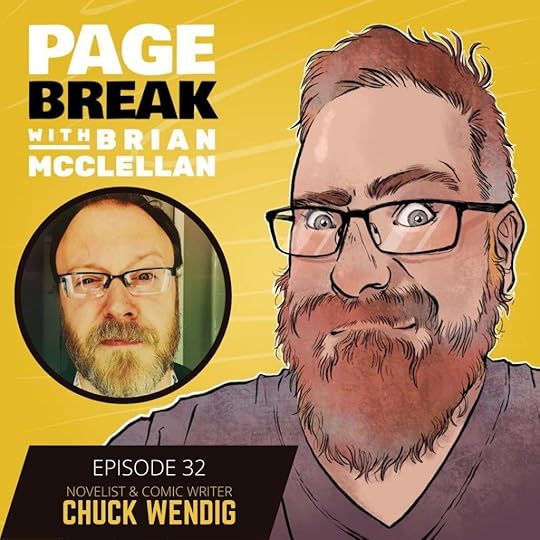
Back at the end of June, 2021, I finally fulfilled a years-long ambition to start a podcast with the first episode of Page Break. I’m not sure why. I write epic fantasy novels for a living (you might know my Powder Mage epic fantasy novels), and I’m good at that and when you have such a coveted gig it can be ill-advised to direct your attention elsewhere. But I did it anyways because so many of us creative professionals love to work on multiple disciplines.
So Page Break was born: a series of casual conversations between two creative professionals that rambled through the often-ignored aspects of their lives and careers. I didn’t really know whether people would listen, or if I would have the time and energy to produce more than a few episodes. To be frank, it was something I knew I’d be mad at myself if I didn’t try, but I didn’t think it would succeed.
Well, my recording with our gracious host Chuck Wendig came out a couple days ago and is episode #32. I’ve had conversations with actors, youtubers, authors, and comedians. People like Joe Abercrombie, Fonda Lee, Mark Hulmes, Robin Hobb, and Daniel Greene have taken the time to sit down with little old me for casual chats about life, creativity, business, hobbies, career, and more. It’s been pretty dang cool and I don’t seem to be stopping.
[ed — I loved doing this podcast and I hope you’ll give a listen]
So sit back, relax, and let me tell you about five things I learned while recording Page Break.
Everything is easier with a little help from your friends
Page Break exists because of my friends. It started simply enough with me bemoaning that I wanted to start a podcast but was intimidated by trying to record both sides of a zoom call. A buddy simply mentioned that Zencastr was a really good option for this and BOOM: I’ve got a program to use. The same thing happened when I asked the musically talented James L Sutter how I would go about commissioning an intro riff and, without being asked, he delivered a series of possible compositions the very next day!
I worked through my worries one at a time. I asked twitter about audio engineer costs and Tom Bishop messaged me privately offering his services for an affordable price. Several of my friends offered to help me with test-interviews so I could get used to talking to someone for an audience. Charlie N. Holmberg’s ended up being episode 5. Many of my author friends were just a text message away for subsequent guest spots.
Now, I caveat this point with the full understanding that I’m in a privileged position: with a decade-long career as an epic fantasy author, I’ve made lots of friends with diverse and useful talents and I know a handful of famous writers. It definitely gave me a head start. But it’s important to remember that your friends are there for you and they may have some good ideas or be willing to help you record a test episode.
Listeners are more forgiving than you’d think
I wanted to make a podcast for three years before I finally got around to recording for Page Break, and during that time the biggest block for me was worrying about quality. I thought I needed the very best physical hardware to record in-person conversations with mics, portable mixers, headphones – the whole shebang. I couldn’t record via zoom or phone because I wouldn’t be able to control anything on their end. Overall, I was convinced that no one would listen unless I had crisp, studio-quality sound.
Turns out that’s not exactly true. People like crisp, studio-quality sound but what they want is to listen to interesting conversations, cool stories, or fascinating facts. You still need a baseline sound quality of course—no one wants to hear bursts of static or sit through long pauses or one person talking louder than the other. But if it’s a good show, listeners are willing to forgive a guest having a low-quality microphone, or a bit of street noise on one end of the line. The content is what matters most.
Success is relative, especially when it comes to making a profit
Over the last eight months or so I’ve learned that podcasting has a very weird measure of success. If you have over a hundred regular listeners, you’ve done quite a good job. After all, that’s a hundred people who tune in to listen to you every episode! That’s pretty awesome if you envision them all sitting in a room together. Unfortunately if you want to break even on your time and costs, those hundred people are worth just a few pennies in ad revenue.
I’ll break down where I currently sit with Page Break. My costs for a month (four weeks) of episodes include about $500 for hosting, editing, graphics, and other misc expenses for things I have no skills or interest in doing myself. Roughly twelve hours of my attention goes into prep and recording. I do consider this part of my free time, so I try not to think too hard about how much writing I could get done with those hours.
So what do I get out of it in a very straight-forward business sense? The podcast currently receives roughly 1000-1600 listens a week depending on the guest. Not too shabby, right? Want to know my revenue? $71 from Patreon and $72 from Acast ads. That’s less than a third of my cash costs, and after 32 episodes of building an audience. Ouch. Good thing I’m doing this for fun!
It’s all about the slow burn
Now that I’ve laid out the start costs of limited success, I should say that I’m doing this for what I hope will be a long term listenership. My first five episodes each received less than 300 listens their opening weeks. As mentioned above, I’ve managed to raise that by a significant margin!
The rule of thumb I’ve heard is that a podcast needs a good two years of regular production to really find and keep their audience. At the moment I’m in the lucky position where I can eat the financial costs and I’m enjoying it enough to eat the time costs. I mentioned “hope” above, and that’s because hanging on to this kind of thing requires quite a lot of it. I hope that listeners will subscribe to my Patreon. I hope that Acast sends my feed more ad revenue. I hope that new listeners will be interested in my books. Which leads me neatly to my next point…
For a creative professional, diversifying can have hard-to-quantify benefits
One of the greatest challenges for any creative professional is keeping themselves in the public consciousness when there is so much noise competing for the attention of readers, watchers, and listeners. When my next novel comes out, IN THE SHADOW OF LIGHTNING, it’ll have been two and a half years since I put out an epic fantasy. Will readers remember who I am? Will they have long since muted my twitter or unsubscribed from my newsletter because those aren’t the things they really care about (my books).
Do you know how much that freaks me out?
Page Break is a small but interesting solution to that. It’s a place for listeners to hear from me and my industry friends every week. I can bring in people like creative director Lauren Panepinto to yak about the Powder Mage covers, or director Joseph Mallozzi to discuss the technical aspects of a Powder Mage TV show. Or I can skip my own work entirely and talk to a revered author like RA Salvatore about his most famous characters and infamous books.
In short, Page Break reminds the listeners that I exist—that my books exist—and that I’m still writing. Hopefully it brings in new readers for my books and introduces my existing readers to the works of people I find interesting. There’s that tricky word again: hope. How many careers exist solely on that?
February 25, 2022
Updates In The Void
It’s hard not to recognize that things are particularly bad right now. Some of it is what we already have been living through: pandemic, climate change, rising right-wing white Christian fascism. Some of it is from the tentacular outgrowths of those wretched seed-beds: Russia’s attack on Ukraine, the attack on trans kids in Texas, the attack on LGBT kids in Florida.
It’s not great, Bob.
I don’t know particularly what to do or say about much of this beyond the obvious choices. On Ukraine, I’m particularly lost. I have no great thoughts or wisdom here, except the clarity that we all should have, which is that war is fucking awful and should be everyone’s last resort, and that none of us should be straining for war, and all of us should be recognizing the costs of war. (This, plus the needling anxiety of old, which is, growing up Gen X and being afraid every night before bed that for some reason, the Soviet Union was going to vaporize your town with a nuclear blast.) I point here to some charities one can support, though in this list is the Red Cross, and the Red Cross has not always stepped up (Haiti, Texas, etc.) despite being the often-number-one place to which one sends donations in times of crisis. So, be advised, there.
On the matter of trans kids under siege in Texas and LGBT kids in danger of erasure and worse in Florida — obviously, call your reps, make your voices heard, follow LGBT voices and signal boost them on this subject. Some charities here will be particularly good to look at:
Trevor Project and Audre Lorde Project
Trans Texas (Transgender Education Network of Texas)
And of course, the ACLU.
If you’ve not subscribed to Parker Malloy’s newsletter, I recommend it.
Finally, you have to vote. And you have to vote for Democrats and Democratic Socialists and independents who support trans kids and freedom for LGBT and for human rights across the board. And here someone will — correctly! — note that it’s a very hard sell to convince people to JUST VOTE HARDER, because it’s not exactly as if the Democrats are covering themselves in glory. They are routinely not fighting as hard as they could be, and often compromise on fights in a way that feels both preemptory and perfunctory. (I call this the “not in the face, not in the face” school of politics, as the Democrats always seem to be flinching even from punches that don’t land, often failing to throw their own punches in return.) They currently control the White House, the House, and the Senate, though with margins that are less robust than we’d like — but they don’t seem as able to accomplish much with those numbers, and so it becomes a very hard sell to just say HEY VOTE MORE OF THEM IN. We did vote them in. The country busted its ass to overturn the Republican control of this country, and it doesn’t always feel like as much has changed. Some of that’s down to their poor messaging, some of it’s down to tough choices or troubled realities, some of it’s down to just not really being the people we want them to be. We fought for them and we want them to fight back, and not just fundraise for the next election.
And yet.
And yet.
We still have to vote when the time comes, voting for the people who are not going to be the ones demanding that we out trans kids and gay kids, and the ones who aren’t going to outlaw and punish abortions, and who are may not be the best of our choices… but who are not actively trying to undo human rights. It’s often a grim choice. I don’t like it. It sucks, and sucks bad, but I don’t know what else there is to do, except letting it all swirl down the drain on principle. But letting it do that means letting a lot of innocent people — in this instance, kids — get hurt in that process.
Anyway. Thoughts. Do with them as thou wilt.
Uhhh. Let’s see, what else is up that isn’t actively awful?
Whoa, What, A Stoker Nomination?
To my great delight and honor, The Book of Accidents has been nominated for a Bram Stoker Award in the Best Novel category, alongside wonderful authors like Cynthia Pelayo, V Castro, Stephen Graham Jones, and Grady Hendrix. I’m really glad the book has found its audience and continues to find new readers. Thanks to all who voted to put it in that slot —
I say again, a great delight and honor.
You can check out all the nominees here!
And a reminder that the paperback of TBOA launches March 15th.

In Which I Do A Keynote
In cautious fingers-crossed please-let-the-pandemic-go-quiet hopes, I’ve accepted an invitation to do the keynote speech at the Colorado Gold Writers Conference Sept 9-11 — registration opens in May!
Speaking of Travel
You did see I’m doing a cool in-person mini-sized book tour with pals Kevin Hearne and Delilah S. Dawson, yeah? New York City! Rhode Island! Boston!
Yeah, The Website Is Still Kinda Ass-Ugly
Good news is, no fresh hacks. Bad news is, I’m still hanging around with this kinda lumpy boring-ass theme, a pre-packaged WP theme. I need a refresher and am looking into some options to figure out where to jump to next. But yes, I’m aware it’s still not as appealing as it could be. Soon!
OKAY BYE
February 24, 2022
Richard Swan: Five Things I Learned Writing The Justice of Kings
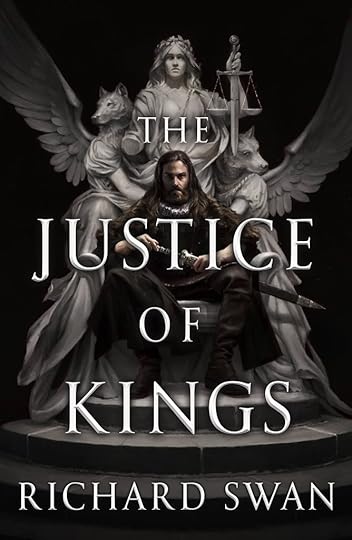
From a major new debut author in epic fantasy comes the first book in a trilogy where action, intrigue, and magic collide. The Justice of Kings introduces an unforgettable protagonist destined to become a fantasy icon: Sir Konrad Vonvalt, an Emperor’s Justice, who is a detective, judge, and executioner all in one. But these are dangerous times to be a Justice….
The Empire of the Wolf simmers with unrest. Rebels, heretics, and powerful patricians all challenge the power of the Imperial throne.
Only the Order of Justices stands in the way of chaos. Sir Konrad Vonvalt is the most feared Justice of all, upholding the law by way of his sharp mind, arcane powers, and skill as a swordsman. At his side stands Helena Sedanka, his talented protégé, orphaned by the wars that forged the Empire.
When the pair investigates the murder of a provincial aristocrat, they unearth a conspiracy that stretches to the very top of Imperial society. As the stakes rise and become ever more personal, Vonvalt and Helena must make a choice: Will they abandon the laws they’ve sworn to uphold, in order to protect the Empire?
***
1. The old writers’ adage “the first million words are practice” was actually pretty accurate for me
Following the sale of my Empire of the Wolf Trilogy to Orbit—very much the realisation of a 20 year dream—I did a little retrospective for myself, putting together a list of all the novels I had ever written, their word counts, and a sort of self-appraisal as to what I had taken away from each book and “phase” in my writing journey. It was a fun and interesting exercise, and I learnt two things: the first was that I really hit my ‘default narrative voice’ at around half a million words; the second was that I wrote and sold The Justice of Kings not long after the big one million (about 1.3). For me, at least, the million-ish-word mark represented a fairly stark shift in my writing fortunes.
2. The traditional publishing process has (so far) involved a lot of hanging around
My agent did forewarn me of this very early on in our relationship, but I was still surprised at just how much of being a debut trad-pubbed author (and I’m only speaking from my perspective as the author) involves entire weeks and sometimes months of very little activity. Exciting developments, such as getting a draft book cover artwork or the first blurbs or a marketing plan, are spikes of engagement in an otherwise lengthy and unyielding radio silence. Having previously self-published a few things, and having had full control over that process, this was a difficult thing to get used to. It’s taken a while for me to stop relentlessly and fruitlessly refreshing my Gmail inbox!
3. I enjoy reading and writing interesting character development over any number of exploding spaceships and collapsing empires (but I love those other things too!)
The Justice of Kings was the first novel I wrote in which I really focused on the individual characters, their motivations, their interactions and messy dynamics, and their development up and down the Mass Effect Paragon/Renegade spectrum. I found that for all the sword fights and murder victims and political manoeuvrings and beheadings and immolations and everything else that is in the Justice of Kings, it really was those messy, interesting dynamics between characters that hooked my interest as a writer more than anything else.
4. The best world building comes from what you don’t see
For me personally, it’s the throwaway in-world references to public figures, holidays and historical events that gives The Empire of the Wolf its verisimilitude. Dan Abnett gave a great example of this in an interview when he referred to Obi-Wan Kenobi’s original reference to the ‘Clone Wars’ in A New Hope, decades before prequel trilogy was released—a tiny, throwaway line but that did a huge amount of work in building Obi-Wan’s backstory and the wider Star Wars meta. Little titbits like that can add a lot of flavour and give the world a lived-in feel.
5. I’ve only really just become comfortable with using allegory
The Justice of Kings is the first novel I’ve written in which I really used the fantasy secondary world as a vehicle to explore modern-day themes and ideas. It’s the first time as a writer I’ve felt able to do this in a way that I hope is effective and nuanced. My previous attempts (few and far between) have been rather ham-fisted and I think that it’s something that, like anything, comes with experience and practice.
***
Richard Swan was born in North Yorkshire and spent most of his early life on Royal Air Force bases in Yorkshire and Lincolnshire. After studying law at the University of Manchester, Richard was Called to the Bar in 2011. He subsequently retrained as a solicitor specialising in commercial litigation. When he is not working, Richard can be found in London with his wonderful wife Sophie, where they attempt to raise, with mixed results, their two very loud sons.
Richard Swan: Website | Twitter
The Justice of Kings: Bookshop | Indiebound | Amazon | B&N | Powells
February 22, 2022
Rob Hart’s Research Toolbox
(ed: Rob Hart is a former journalist, and so if you need someone to tell you how to start researching for your novel? He’s your guy. (Also, his newest, Paradox Hotel, fucking rocks. It’s slick, cinematic sci-fi noir.)
Around when I was 18, I decided I wanted to write novels. I was failing out of an art conservatory, and realized graphic design was not in my future. When it was time to change majors, I figured: a creative writing degree is a clear path to waiting tables but if I go for a journalism degree, at least I can make some money!
If you read that and decide you don’t want to take any advice from me, I will understand. But… I was 18. Cut me a little slack, okay?
Anyway, I excelled in my school’s journalism program, then landed a job working for a daily newspaper in New York City, which I did for four years. At which point I saw the industry was on the verge of cratering, so I turned tail and ran for the hills.
But journalism placed some great tools into my fiction-writing toolbox. I’ve got good observational skills. I type real damn fast. I don’t miss deadlines. I understand the need to kill darlings, because often you’re dealing with a word count (or in my case, column inches), and a sweet-ass detail or quote might not fit—and that’s okay.
I’m not here to talk about that. I’m here to talk about research. That, I think, is my writing superpower. It helped me on The Warehouse, which was about what would happen if one online retailer completely took over the American economy and housing market (and then, slowly, the government). And it helped me again with The Paradox Hotel, which is about time travel but also evil billionaires and Buddhism and stuff.
For your reading pleasure, here is my research toolbox. As with any and all writing advice: your mileage may vary. Take what works for you and discard the rest. Oh, also, some of this would be tough to do in the United States of COVID, so make sure to have a mask handy.
CREATE BASKET, FILL WITH IDEAS. Every time I get an idea I think has legs, I create a Google Doc. For months, The Paradox Hotel was a Google Doc that said “time travel hotel.” As I come across relevant books or articles, or have stray ideas I think might fit the concept, I toss it in there.
I like Google Docs because they’re collaborative, easy enough to access, and I can keep an icon on my phone’s homescreen, so even if I’m on the subway or standing in line at the coffee shop or waking screaming from a nightmare, I can jot down notes.
But you do you. Carry a notebook. Shout ideas at strangers. Get notes tattooed on your arm. Just find something that fits your style.
ASSEMBLE YOUR AVENG… ER, UH, SOURCES. For me, there are two types of research. Direct and indirect sources.
Direct sources are explicitly about the subject matter you’re writing about. They can come from books, but also documentaries and news articles. So for Warehouse, it was books and articles on Wal-Mart and Amazon (Wal-Mart being better for this purpose; Amazon is a new company and not as much has been written about it, whereas Wal-Mart has been around since the 60s, so there’s a much deeper record of how it reshaped the economy).
For Paradox, it was a lot of time travel and quantum physics and Eastern philosophy.
Indirect research is more about tone: for Warehouse, I read The Trial by Franz Kafka and The Handmaid’s Tale by Margaret Atwood. But I also read a lot of mainstream thrillers just to learn more about their mechanics. For Paradox, I watched movies like The Grand Budapest Hotel and Bad Times at the El Royale and Timecop and Primer.
Sometimes you need to live in an adjacent fictional world for a little bit. Besides giving you more of a frame of reference, it’ll help you see tropes and ideas that you can put your own spin on.
Pro-tip: Want to make your life a lot easier? Read your research books in eBook format. You can highlight stuff, and then it spits all your highlights into a file. It is game-changing.
THE NEWS IS YOUR FRIEND EVEN THOUGH IT HATES YOU. If you’re writing speculative fiction, or anything with an eye toward current events, it’s good to read the news. A lot. Which can sometimes be very depressing! But I’m a news junkie and besides informing my books (I tend to enjoy writing about how billionaires are douchebags), it’s also where I get most of my ideas. The entirety of Warehouse sprung out of this one article.
This is why a Google Doc, or just some other repository, is important to have. My Warehouse document was 80 pages long. Half of that was just links.
News articles are also a great way to find information that you don’t need to waste time reading a whole book about. For example, in Paradox, time travel is what the space industry is turning into: it was developed by the government and later, as a way to raise money, was opened up to tourism. So I did a little reading on the commercialization of space travel. And I learned why reaching space is so valuable (it ain’t just to send rich people to ride on rockets that look like wangs—but you can read the book to find out more…).
MAKE NEW FRIENDS! People like to talk about themselves and their jobs. Use this.
Before I settled on Paradox, I was working on a book about a world where the power grids got wiped out by massive solar flares. I found an expert at the forefront of sounding the alarm on this. I sent him an e-mail, told him I was an author working on a book about the subject, and asked him if I could send him some questions. He said yes. I also spoke to Con Ed, the power utility in New York (which is where the book would have been based), to talk about their countermeasures, the science of it, what recovery would look like. And I spoke to the Office of Emergency Management, trying to figure out what the response to a massive, permanent blackout would entail. Those last two, I contacted their press/PR departments.
How do you find these resources? Think about your subject, and who the authority on it might be. My second book is set in a strip club; I had a friend put me in contact with a friend of his who was a stripper. My fifth book was about the heroin crisis on Staten Island; I met with a recovered heroin addict who lived on the island. Paradox features a trans character; I talked to two friends who are trans to get their perspectives.
Reach out respectfully, offer to buy coffee or a meal if you’re setting up an in-person interview (always the best kind), record the conversation (with their permission) but don’t be afraid to jot down notes in case the recording fails, and do your research beforehand so you’re asking good, targeted questions. Their job is to fill in gaps in your research, and provide personal anecdotes you can use to inform your story.
And always ask the most useful questions in journalism: is there anything else you think I could have asked, or information this has brought up that you think is worth knowing? That’s a good way to end things. Sometimes they’ll see an aspect that you didn’t even think of, and that’ll bring you down new paths.
GO TO THERE. For Paradox I knew I needed the hotel to have a “look.” And we all know what hotels look like, but there was a lot of value in being inside a hotel, and looking at it from a storytelling perspective.
I knew the Paradox needed a loot, and after a whole lot of Google Image searching, I settled on the TWA Hotel at JFK (I think a lot of hotel-based stories lean into Art Deco design, whereas the TWA is mid-century modern, which looks both retro and futuristic, which worked well for a time travel book…).
Lucky for me the TWA hotel was nearby. I wrote a nice e-mail, which I sent to a few of the addresses on the website (the media contact, the manager, the archivist). An event coordinator got back to me and gave me a tour. He told me about the construction, design, and history of the space, and let me take a ton of photos, (you can find some of them on my Twitter and Instagram). It helped immensely—not just in being able to visualize my own hotel, but in creating action and momentum in the plot.
Pro-tip: That Google Doc or research file you’re keeping? Create an acknowledgements list. This way you don’t forget to thank the hotel event coordinator when you finish the book two years later.
GOOGLE EARLY, GOOGLE OFTEN. Seriously, the Googs is your best friend—sometimes you just have to spend a day shotgun-searching relevant phrases and picking through endless links to find what you need.
But also: Image search is how I found the TWA Hotel. Street view is like a writer’s best friend. Writing about an unfamiliar city or neighborhood? Boom. Go for a little “walk.” I’ve used map and street view a lot when writing books about unfamiliar locations, or locations I hadn’t been to in a long time.
Street view is also helpful if you can’t afford to travel—or don’t want to, what with the world being on fire.
PATRONIZE YOUR LOCAL LIBRARY; YOU ALREADY PAID FOR IT [WITH TAXES]. Your library is chock-full of resources. Reference books. Old newspapers. Some of which haven’t been digitized so you wouldn’t be able to access them otherwise.
And the best part? The very best part?! Librarians are awesome. You can say “hey I am looking for information on this subject” and instead of getting borked by Google search algorithms, or spending hours clicking through non-relevant links, you get a real-life smart person who can help guide you.
It’s like the internet but way less frustrating.
This is an especially good resource if you’re writing anything historical, especially if it’s about a certain town or city. Local libraries (should) have local newspapers going back decades, and again, a lot of this shiz will not have been digitized; i.e., you ain’t gonna find it on Google.
KNOW WHEN TO STOP. This is very important. For me. I like the research phase. I like learning new stuff. But I will often fall down rabbit holes. Like this book on warehouse management which I read half of for Warehouse and was a complete waste of time.
Eventually you have to know when you have enough information. And, sure, you’ll find new things to check along the way. But, how do you know when enough is enough?
I dunno. You have to figure that out. For me, it’s when I’m getting completely exhausted by the work and the story is starting to claw its way out of my chest. Then I know it’s time to take all that research and write like a motherfucker.
***
Rob Hart is the author of The Paradox Hotel. His last novel, The Warehouse, sold in more than 20 languages and was optioned for film by Ron Howard. He also wrote the Ash McKenna crime series, the short story collection Take-Out, and Scott Free with James Patterson.
Rob Hart: Website | Twitter | Instagram
The Paradox Hotel: iBooks | Barnes & Noble | IndieBound | Amazon
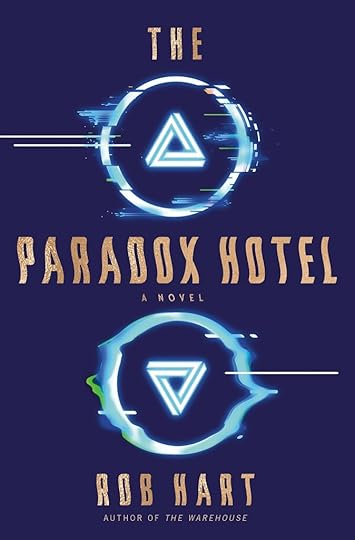
Delilah S. Dawson: Ten Ways To Torture People (In Fiction)

Most of us move through life hoping everything will go well and turn out exactly as we’ve imagined it. Most of us are therefore disappointed. This is even more true for characters in books, because without failure and pain and chaos, there is no story. A book in which everything goes right is exactly one sentence long. That means it’s up to the writer to uniquely torture their characters. In my most recent book, THE VIOLENCE, three generations of women use a pandemic of random violence to escape the cycle of abuse they’ve been stuck in. These three women have to fight everything from a new pandemic to their loved ones to the police to the cashier at a drug store to professional wrestlers. This book was an exercise for me in torturing your characters for the most satisfying and cathartic ending possible. Here’s how to do that.
Make torture part of the premise. When you’re developing the idea for your book, you don’t want to start with a perfect person in a perfect world. You want a character with specific flaws and fears who is uniquely challenged by their world. Pain should be baked right into that backstory. Even if you want to start with a generally happy character and take everything away from them, they should still have flaws and fears you can prey on while melting them down and forging them in a crucible of pain.
Throw thumbtacks in the cake mix. When I wrote my first few books, I wanted the characters to be relatable to literally everyone, which never works. We don’t want mild, smiling cardboard cutouts; we want characters so real and rich and messed up that it’s like we already know them. That means they have to be flawed—and not, “he’s so handsome no one believes he’s a spy”. Real flaws. Deep wounds. Troubled backstory that comes up at the most inconvenient of times. The key is to make them flawed but somehow likeable, meaning that if he’s a gruff jerk, we immediately learn it’s because he lost his entire family in a werewolf attack—and then we see him save a kitten when no one is looking. Maybe giving a character flaws and fears isn’t technically torturing them… but it’s more like throwing thumbtacks into the cake mix. Make it real enough and they’ll torture themselves.
Kick off with failure. I wrote an article for Crimereads called ‘Make the Face Match the Ass’ (https://crimereads.com/delilah-s-daws... focuses on creating symmetry between the beginning and ending of a book. Since your protagonist generally triumphs at the end of the book, it’s nice to give them a symmetrical failure at the beginning. That means that if your character beats the bad guy in a hula hooping competition at the end, we see him suffer a tragic hula hoop-related accident at the beginning of the book. This failure can be as simple as being too shy to talk to a crush or as huge and terrible as Louis allowing his toddler to get run over in Pet Sematary. The bigger the fall, the better the rise.
The obstacle is the way. From the very beginning, make sure that there are all sorts of built-in problems for your character—don’t make it easy for them. You want to keep your reader on the edge of their seat, not knowing what will happen next. If possible, end every chapter on a cliffhanger or a question. If a chapter ends with a character happily falling asleep, it’s easy to put the book down and scroll through Instagram. If the character is falling asleep and hears a noise downstairs when they live alone, the reader may be compelled to keep reading.
When you’re not sure what to do next, think about the worst possible thing that could happen—and make it happen. Unless you’re a very strict outliner, chances are you’ve left some wiggle room for discovery in your first draft. Sometimes, you come up with the perfect idea while driving to work and feel like you’ve been tongue-kissed by the muse. Sometimes you come to a roadblock and your character is basically staring up at you like God in heaven, asking what comes next. That’s the perfect moment to throw a boulder at them. Let tragedy strike. Have them be attacked. Have their ex show up. Hit them with food poisoning. At the very least, throw a terrible, thundering downpour on them. Then they can’t stare up at you anymore.
Find your Jayne Cobb. It can be tempting to create a cast of characters who are all beautiful and perfect and lovely and get along famously, but again, that’s not a story—that’s a Publix commercial. When you add secondary characters, love interests, and acquaintances, build in that friction. Old grievances, moral differences, annoying habits, opposing wants and needs. Give your characters a reason to argue, to fight, to seethe. Sometimes the most interesting parts of the story come from what naturally happens between characters in quiet moments. It never hurts to throw a raging asshole into the mix and see what is extruded on the other side.
Even one small pebble can feel like the end of the world. Sure, a car accident or alien attack brings strife, but don’t forget how quickly the little things add up. If you don’t believe me, just put a pebble in your shoe and leave it there all day. Raccoons stealing food, a sneeze when silence is necessary, a child who won’t stop crying—it all adds up. If your character is on a journey through the forest and time is of the essence, a horse throwing a shoe is the biggest problem in the world. Don’t neglect the small things that become big things.
But don’t forget the big things. So we’ve got little things and people and fears and flaws that can create friction, but there’s so much more! Most characters are at odds with big things, too—the very foundations of the world. Culture, economics, laws, mores, religion. If a character loses their shoes in the swamp, they might not be allowed in the gas station if the guy up front is really serious about No Shirt, No Shoes, No Service. I’ll never forget Louis (yes, another Louis) from Ghostbusters trying every door and window of the upscale restaurant that wouldn’t let him in and then falling prey to the Terror Dog because of a few locked doors and some snooty waiters. When in doubt, put your character in an altercation with some authority and see where they end up.
At the All Is Lost moment, dial the torture up to 11. Right before The Big Fight or whatever you have as a climax, there’s always an All Is Lost moment. That’s when it feels like your character can never possibly win and, well, all is lost. It’s the dark night of the soul, the moment the protagonist wants to give up. Your job is to push this moment as far as you can—mentally, emotionally, physically. You need your backstory, flaws, fears, wounds, discomfort, betrayal, and hopelessness to all come together in one hot, lumpy stew for your protagonist to swallow down and fight past. We really have to believe they can’t win or can’t go on.
All this pain will be valuable to you someday. When you hit the climax of the story, that’s when you take your long list of tortures and show how your protagonist uses what they’ve learned to fight back. Take that pebble out of their shoe and load it into a slingshot. The purpose of all that torture was to mold your protagonist into someone capable of defeating not only the bad guy—but also that poor sap they were at the beginning, the weak wiener with all the worries. The harder you’ve pushed them, the higher they can rise when it’s go time. That’s what makes us stand up and cheer—having watched this character go through hell, keep on crawling, and finally triump, just like we all wish we could do (without having to suffer all the torture, of course).
But if you really want to see how I torture my characters, please pick up a copy of THE VIOLENCE. It’s available in all the usual places as a hardcover, e-book, or audiobook. Chuck liked it, so it must be good, right? [ed: I totally fucking loved this book and from page one you get the sense it’s something special, also here is where I note Delilah, myself, and Kevin Hearne will be going on a short li’l book tour next month: NYC, Rhode Island, Boston-area.]
Also, someone is bludgeoned to death with a bottle of Thousand Island dressing, and that has to count for something.
***
Delilah S. Dawson is the author of the New York Times bestseller Star Wars: Phasma and Star Wars Galaxy’s Edge: Black Spire, The Violence, Mine, Camp Scare, the Minecraft: Mob Squad series, the Hit series, the Blud series, the Tales of Pell (with Kevin Hearne), and the Shadow series (written as Lila Bowen), as well as the creator-owned comics Ladycastle, Sparrowhawk, and Star Pig, plus comics in the worlds of Firefly, Star Wars, the X-Files, Adventure Time, Rick & Morty, Marvel Action: Spider-Man, Disney Descendants, Labyrinth, and more. Find her online at delilahsdawson.com.




